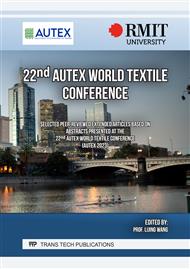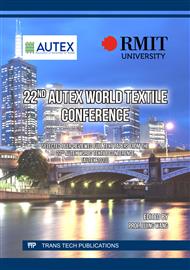p.39
p.49
p.61
p.67
p.79
p.93
p.107
p.115
p.125
Lightness and Hue Dependencies of Color Difference Thresholds in Textiles under High-Illuminance Conditions
Abstract:
In this study, the color difference thresholds of the human eye for textiles in a wide range of colors under high-illuminance conditions were examined. As the high-illuminance conditions, 2856 K-2000 lux and 6504 K-2000 lux, which are in the range of illumination conditions used in spaces that highlight products such as show windows, were used. It was observed that people cannot generally perceive color differences in textiles smaller than 4.29 ΔE*ab. Also, the color difference threshold varied depending on the color center and lightness of the textiles observed. Color differences in red and blue colored textiles were easier to be perceived than other colored textiles, while those in yellow colored textiles were the hardest to be perceived. It was also found that people are generally better able to discriminate colors between dark textiles than between light textiles. Meanwhile, the correlated color temperature of the illuminant, that is, whether it was a warm-white (2856 K) illuminant or a cool-white (6504 K) illuminant, did not significantly affect people’s perception of color differences in textiles under high illuminance conditions.
Info:
Periodical:
Pages:
125-129
Citation:
Online since:
March 2024
Authors:
Keywords:
Price:
Сopyright:
© 2024 Trans Tech Publications Ltd. All Rights Reserved
Share:
Citation:



